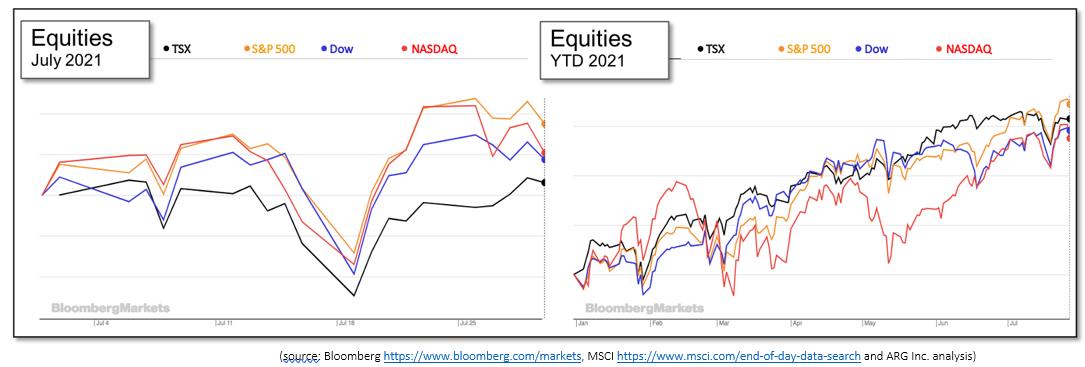Last Month in the Markets – July 1st – 30th, 2021
What happened in July?
The first month in the second half of 2021 has concluded. Overall the results were a continuation of the solid performance shown in preceding six months. More specifically, the results for equities in July were similar to June. Both months started reasonably well, endured a small mid-month dip in values and then managed a recovery for the balance of the month. On balance, July’s recovery was about the same as June’s. The TSX did slightly better in June, the S&P 500 returned an identical percentage, the Dow reversed June’s loss, and the NASDAQ provided a solid performance; but not as strong as June’s lofty 5%.
Progress against the pandemic is still driving markets. By the time that July had concluded the forces included the on-going rise of virus variants, a stalling vaccination rollout in the U.S. and elsewhere, increasing cases counts, new record levels of infection in many jurisdictions, nearly 100% of deaths comprised of unvaccinated people, and the re-introduction of restrictions to slow the spread of the virus.
The recovery of Gross Domestic Product (GDP) in North America has been impressive. Once restrictions began to lift, pent-up demand and access to goods and services has moved economic indicators ahead briskly. The drivers have been the unleashing of savings caused by deferred purchases and the spending of government payments to individuals. The expectation is that consumer spending, which comprises about two-thirds of GDP, will continue to power economic expansion as the recovery continues.
The concern that inflation would lead to central bank actions to contain it has fallen slightly. The effects of increasing demand and supply shortages appears to temporary. Commodity price increases have slowed, manufacturing levels have grown, and the services sector’s recovery should help return inflation closer to the Federal Reserve’s desired level of a 2% long-term average. With inflation more in-check, the earlier guidance that interest rate increases should materialize in 2023 seems more likely.
American consumer inflation rose to 5.4% in June, the highest year-over-year price increase during a month since 2008 and the global financial crisis. Prices of goods and services fell during the early months of the pandemic, and June 2021 price spikes are being compared against the lows of June 2020. https://www.federalreserve.gov/newsevents/pressreleases/monetary20210616a.htmhttps://www.bankofcanada.ca/2021/07/opening-statement-140721/
Despite the high rate of inflation, the U.S. interest rates are unchanged. Federal Reserve Chair, Jerome Powell, announced that both interest rates and bond-buying programs would remain in-place following the meeting of the Federal Open Market Committee. The dual mandate of managing inflation and maximizing employment continues to require $120 Billion in bond purchases monthly and its benchmark interest rate, the federal funds rate, to remain at a range of 0 to ¼ percent.
Canadian inflation slowed somewhat in June compared to May, down to 3.1% from 3.6%. The core inflation rate also improved and sits at 2.2%. Like the Federal Reserve, the Bank of Canada will closely monitor inflation levels and respond with monetary actions like interest rate increases should they feel price increases are more permanent than the conditions caused by reopening like supply chain shortages and releasing pent-up demand. https://www.theglobeandmail.com/business/economy/article-canadas-annual-rate-of-inflation-hit-31-in-june/
The Bank of Canada also held its benchmark interest rate unchanged at ¼% as the country and world continue to emerge from the pandemic. The central bank does not expect to raise rates until the second half of 2022 at the earliest even as variants of concern continue to rise and virus containment is not universal.
The two themes discussed in detail at the press conference were increased confidence and continued attention. Governor, Tiff Macklem, mentioned falling case counts, progress on vaccinations and easing measures as evidence of recovery and an expectation for its continued momentum. Also, on-going scrutiny must be applied to the “dynamics of recovery and inflation”.
As expansion continues, the Bank’s forecast for inflation has been increased. Bank of Canada economists believe that inflation will be above 3% for the balance of 2021, before nearing the Bank’s target of 2% during 2022, rise again in 2023 and then back to 2% in 2024. The belief is that pent-up demand is outstripping decreased supply temporarily; when supply rebounds inflation is expected to slow, and more typical price increases will return.
What’s ahead for August and beyond?
Case counts driven by vaccination levels will continue to heavily influence markets. The surest way to reach full recovery is to prevent the need for social and economic measures to control the virus.
As of August 1st, 72% of Canadians have received at least one dose and 60% are fully vaccinated placing us in 9th and 11th place, respectively, among countries. In the U.S., 57% of Americans have received one dose or more and 49% are fully vaccinated (32nd and 27th place, respectively). https://www.nytimes.com/interactive/2021/world/covid-vaccinations-tracker.html


